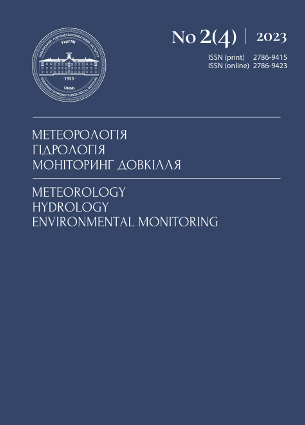CHANGES IN ATMOSPHERIC AIR POLLUTION AND FUEL COMBUSTION EFFICIENCY IN UKRAINIAN CITIES DUE TO MILITARY ACTIONS
Ukrainian Hydrometeorological Institute of the State Emergency Service of Ukraine and National Academy of Sciences of Ukraine, Kyiv, Ukraine
https://orcid.org/0000-0003-3038-5960
Rybchynska Valeriia
Ukrainian Hydrometeorological Institute of the State Emergency Service of Ukraine and National Academy of Sciences of Ukraine, Kyiv, Ukraine
https://orcid.org/0009-0008-5343-8723
Savenets Mykhailo
Ukrainian Hydrometeorological Institute of the State Emergency Service of Ukraine and National Academy of Sciences of Ukraine, Kyiv, Ukraine
https://orcid.org/0000-0001-9429-6209
Abstract
References
1. Apituley, A., Pedergnana, M., Sneep M., et al. (2022). Sentinel-5 precursor/TROPOMI Level 2 Product User Manual Carbon Monoxide. Royal Netherlands Meteorological Institute (KNMI): The Netherlands.
2. Assessment of the Environmental Impact of Military Activities During the Yugoslavia Conflict. Preliminary Findings. (1999). The Regional Environmental Center for Central and Eastern Europe.
3. Austin, J. E. ,& Bruch, C.E (Eds.). (2000). The Environmental Consequences of War: Legal, Economic and Scientific Perspectives. Cambridge University Press.
4. Borsdorff, T., García Reynoso, A., Maldonado, G., Mar-Morales, B., Stremme, W., Grutter, M., & Landgraf, J. (2020). Monitoring CO emissions of the metropolis Mexico City using TROPOMI CO observations. Atmospheric Chemistry and Physics, 20(24), 15761–15774. https://doi.org/10.5194/acp-20-15761-2020
5. Du, Z., Sarofim, A. F., Longwell, J. P., &Tognotti, L. (1991). The CO/CO2 Ratio in the Products of the Carbon-Oxygen Reaction. In Fundamental Issues in Control of Carbon Gasification Reactivity (pp. 91–106). Springer Netherlands. https://doi.org/10.1007/978-94-011-3310-4_5
6. Eskes, H., van Geffen, J., Boersma, F., et al. (2022). Sentinel-5 precursor/TROPOMI Level 2 Product User Manual Nitrogendioxide. Royal Netherlands Meteorological Institute (KNMI): The Netherlands.
7. Griffin, D., McLinden, C. A., Dammers, E., Adams, C., Stockwell, C. E., Warneke, C., Bourgeois, I., Peischl, J., Ryerson, T. B., Zarzana, K. J., Rowe, J. P., Volkamer, R., Knote, C., Kille, N., Koenig, T. K., Lee, C. F., Rollins, D., Rickly, P. S., Chen, J., … Makar, P. (2021). Biomass burning nitrogen dioxide emissions derived from space with TROPOMI: methodology and validation. Atmospheric Measurement Techniques, 14(12), 7929–7957. https://doi.org/10.5194/amt-14-7929-2021
8. Goldberg, D. L., Lu, Z., Oda, T., Lamsal, L. N., Liu, F., Griffin, D., McLinden, C. A., Krotkov, N. A., Duncan, B. N., & Streets, D. G. (2019). Exploiting OMI NO2 satellite observations to infer fossil-fuel CO2 emissions from U.S. megacities. Science of The Total Environment, 695, 133805. https://doi.org/10.1016/j.scitotenv.2019.133805
9. Ialongo, I., Bun, R., Hakkarainen, J., Virta, H., & Oda, T. (2023). Satellites capture socioeconomic disruptions during the 2022 full-scale war in Ukraine. Scientific Reports, 13(1), 14954. https://doi.org/10.1038/s41598-023-42118-w
10. Lama, S., Houweling, S., Boersma, K. F., Eskes, H., Aben, I., Denier van der Gon, H. A. C., Krol, M. C., Dolman, H., Borsdorff, T., &Lorente, A. (2020). Quantifying burning efficiency in megacities using the NO 2 ∕CO ratio from the Tropospheric Monitoring Instrument (TROPOMI). Atmospheric Chemistry and Physics, 20(17), 10295–10310. https://doi.org/10.5194/acp-20-10295-2020
11. Lama, S., Houweling, S., Boersma, K. F., Aben, I., Denier van der Gon, H. A. C., &Krol, M. C. (2022). Estimation of OH in urban plumes using TROPOMI-inferred NO2/CO. Atmospheric Chemistry and Physics, 22(24), 16053–16071. https://doi.org/10.5194/acp-22-16053-2022
12. OESD (2022). Environmental impacts of the war in Ukraine and prospects for a green reconstruction. Retrieved from https://www.oecd.org/ukraine-hub/policy-responses/environmental-impacts-of-the-war-in-ukraine-and-prospects-for-a-green-reconstruction-9e86d691/ (Accessed: 28.08.2023)
13. Payne, C. R. ,& Sand, P.H (Eds.). (2011). Gulf War Reparations and the UN Compensation Commission. Environmental Liability. Oxford University Press.
14. Sadiq, M., &McCain, C. (Eds.). (1993). The Gulf War Aftermath: An Environment Tradegy. Springer Netherlands.
15. Sasmoko, Imran, M., Khan, S., Khan, H. ur R., Jambari, H., Musah, M. B., & Zaman, K. (2023). War psychology: The global carbon emissions impact of the Ukraine-Russia conflict. Frontiers in Environmental Science, 11. https://doi.org/10.3389/fenvs.2023.1065301
16. Savenets, M., Osadchyi, V., Komisar, K., Zhemera, N., &Oreshchenko, A. (2023). Remotely visible impacts on air quality after a year-round full-scale Russian invasion of Ukraine. Atmospheric Pollution Research, 14(11), 101912. https://doi.org/10.1016/j.apr.2023.101912
17. Saw, G. K., Dey, S., Kaushal, H., & Lal, K. (2021). Tracking NO2 emission from thermal power plants in North India using TROPOMI data. Atmospheric Environment, 259, 118514. https://doi.org/10.1016/j.atmosenv.2021.118514
18. Silva, S. J., Arellano, A. F., & Worden, H. M. (2013). Toward anthropogenic combustion emission constraints from space‐based analysis of urban CO2 /CO sensitivity. Geophysical Research Letters, 40(18), 4971–4976. https://doi.org/10.1002/grl.50954
19. Solomon, N., Birhane, E., Gordon, C., Haile, M., Taheri, F., Azadi, H., &Scheffran, J. (2018). Environmental impacts and causes of conflict in the Horn of Africa: A review. Earth-Science Reviews, 177, 284–290. https://doi.org/10.1016/j.earscirev.2017.11.016
20. UNEP (2023). The toxic legacy of the Ukraine war. Retrieved fromhttps://www.unep.org/news-and-stories/story/toxic-legacy-ukraine-war (Accessed: 28.08.2023)
21. Wan, N., Xiong, X., Kluitenberg, G. J., Hutchinson, J. M. S., Aiken, R., Zhao, H., & Lin, X. (2023). Estimation of biomass burning emission of NO2 and CO from 2019–2020 Australia fires based on satellite observations. Atmospheric Chemistry and Physics, 23(1), 711–724. https://doi.org/10.5194/acp-23-711-2023
22. WWF (2022). Assessing the environmental impacts of the war in Ukraine. Retrieved fromhttps://wwfcee.org/our-offices/ukraine/assessing-the-environmental-impacts-of-the-war-in-ukraine (Accessed: 28.08.2023)
23. Zalakeviciute, R., Mejia, D., Alvarez, H., Bermeo, X., Bonilla-Bedoya, S., Rybarczyk, Y., & Lamb, B. (2022). War Impact on Air Quality in Ukraine. Sustainability, 14(21), 13832. https://doi.org/10.3390/su142113832
24. Zhang, C., Hu, Q., Su, W., Xing, C., & Liu, C. (2023). Satellite spectroscopy reveals the atmospheric consequences of the 2022 Russia-Ukraine war. Science of The Total Environment,869, 161759. https://doi.org/10.1016/j.scitotenv.2023.161759
25. Osadchyi V., Oreshchenko A., Savenets M. (2023). Satellite monitoring of fires and air pollution. State Emergency Service of Ukraine, National Academy of Sciences of Ukraine, UkrGMI, https://doi.org/10.15407/uhmi.2023_1[in Ukrainian].
26. Rybchynska V.O., Savenets M.V. (2023). The use of satellite data of atmospheric air pollution to assess the effectiveness of combustion processes on the territory of Ukraine. Hydrology, hydrochemistry and hydroecology, 2(68), 43-55, https://doi.org/10.17721/2306-5680.2023.2.5[in Ukrainian].

